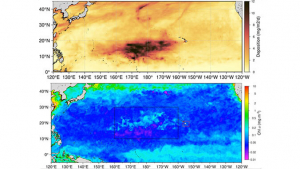When the Kīlauea volcano erupted in May 2018 on Hawaiʻi Island, an enormous amount of ash was released into the atmosphere in a plume nearly 5 miles high. A new study by an international team of researchers—including from the University of Hawaiʻi at Mānoa School of Ocean and Earth Science and Technology (SOEST)—revealed that a rare and large summertime phytoplankton bloom in the North Pacific Subtropical Gyre in summer 2018 was prompted by ash from Kīlauea falling on the ocean surface approximately 1,200 miles west of the volcano. The research was published in JGR Oceans .

"The scale and duration of this bloom were both massive, and probably the largest ever reported for the North Pacific," said David Karl, study co-author, Victor and Peggy Brandstrom Pavel Professor and director of the Center for Microbial Oceanography: Research and Education in SOEST. "Our study shows the connection between the eruption of Kīlauea and bloom formation far from the volcano. This can be used to refine our understanding of phytoplankton bloom dynamics and to improve our understanding of the ocean's carbon cycle."
Despite being one of the most active volcanoes in the world with multiple eruptions in the past 40 years, Kīlauea's volcanic ash had not previously been linked to open ocean phytoplankton blooms. The 2018 eruption of Kīlauea was one of the largest in more than 200 years, injecting millions of cubic feet of molten lava into the waters off Hawaiʻi Island, and releasing an estimated 50 kilotons per day of sulfur dioxide and about 77 kilotons per day of carbon dioxide into the atmosphere.
Kīlauea's impact near and far
Previous research led by UH Mānoa oceanographers showed that as lava flowed into the ocean, it warmed nutrient-rich bottom waters, making them more buoyant. The nutrient-rich deep water rising to the sunlit surface stimulated phytoplankton growth, resulting in an extensive plume of microbes offshore of Hawaiʻi Island. Volcanic ash can be transported much farther distances by winds, especially during explosive eruptions that inject materials high into the atmosphere.
"After the 2018 eruption, the prevailing winds transported ash particles to the west," said Wee Cheah, study corresponding-author and senior lecturer in the Institute of Ocean and Earth Sciences at Universiti Malaya. "The trajectories of the ash were recorded by Earth-orbiting satellites that detect changes in the optical clarity of the atmosphere, the so-called aerosol optical depth. Depending on the density, size, and shape of the particulate matter and local atmospheric conditions, especially rainfall, the ash eventually falls out of the atmosphere and into the surface ocean."
In addition to tracking atmospheric transport of ash across the Pacific Ocean, study lead author Chun Hoe Chow, associate professor in the Department of Marine Environmental Informatics at the National Taiwan Ocean University, and co-authors also used satellite data to detect ocean color, an indirect measure of the presence or absence of phytoplankton, which revealed a massive bloom near the dateline. The team conducted a comprehensive analysis of the observations and investigated physical conditions to explain both the timing and the location of the surface bloom, a feature that is not typical in this region.
"The waters in the open ocean of the Pacific are nutrient depleted and the addition of volcanic ash, especially iron in the ash, and to a lesser extent other trace elements and possibly phosphate, can stimulate the growth of marine phytoplankton, especially the so-called nitrogen-fixing microbes that can growth in the absence of additional nitrogen," said Karl.
For the entire story, visit the SOEST website .
The post Kīlauea volcano ash prompts largest open ocean phytoplankton bloom first appeared on University of Hawaiʻi System News .






